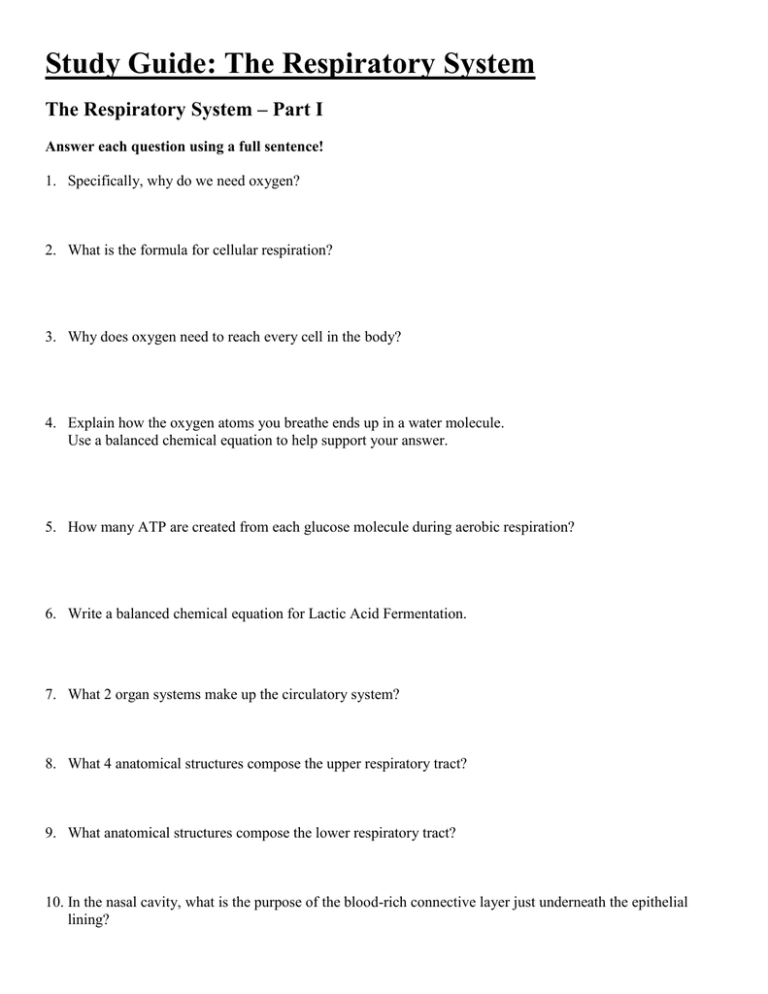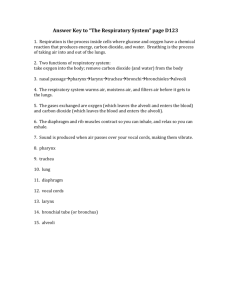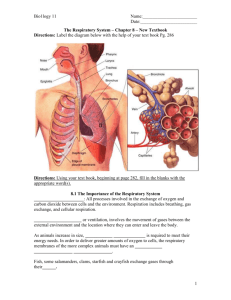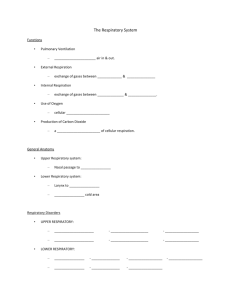Respiratory System Study Guide: Anatomy & Physiology
advertisement

Study Guide: The Respiratory System The Respiratory System – Part I Answer each question using a full sentence! 1. Specifically, why do we need oxygen? 2. What is the formula for cellular respiration? 3. Why does oxygen need to reach every cell in the body? 4. Explain how the oxygen atoms you breathe ends up in a water molecule. Use a balanced chemical equation to help support your answer. 5. How many ATP are created from each glucose molecule during aerobic respiration? 6. Write a balanced chemical equation for Lactic Acid Fermentation. 7. What 2 organ systems make up the circulatory system? 8. What 4 anatomical structures compose the upper respiratory tract? 9. What anatomical structures compose the lower respiratory tract? 10. In the nasal cavity, what is the purpose of the blood-rich connective layer just underneath the epithelial lining? 11. In the nasal cavity, what is the purpose of the mucus? 12. In the nasal cavity, what is the purpose of the cilia? 13. In the nasal cavity, what is the purpose of the conchae bones? 14. Why is it necessary to have a large surface area within the nasal cavity? 15. Where in the nasal cavity are the olfactory receptors located? 16. What is the purpose of the olfactory receptors? 17. What is the purpose of the hard palate? 18. Why is it important that the soft palate is flexible? 19. List two functions of the paranasal sinuses? 20. What are the 3 divisions of the pharynx called? 21. What are the 3 types of tonsils and where is each found? 22. What do the tonsils do? 23. What is tonsillitis? 24. List two ways in which tonsillitis may be treated. 25. What is the common name for the larynx? 26. Between what 2 respiratory structures is the larynx located? 27. What is the Adam’s apple? 28. Where is the epiglottis located? 29. Why is the function of the epiglottis? 30. Why does the epiglottis need to be made of elastic cartilage as opposed to hyaline cartilage? 31. Where are the true vocal cords located? 32. What sounds of speech do the vocal cords produce, vowels or consonants? 33. What produces the sounds of consonants? 34. What is the glottis? 35. What is the common name for the trachea? 36. Why does the trachea have ciliated mucosa when the nasal cavity also has this? 37. How does smoking affect the cilia of the trachea? 38. Why are the rings of hyaline cartilage in the trachea a “C” shape instead of completely round? 39. Research: What is a tracheostomy and specifically where is it placed within the trachea? 40. How does the Heimlich maneuver help someone who is seriously choking? 41. How many lobes compose the left human lung? The right human lung? 42. Draw a picture of the lungs and label the apex and base of each. 43. What is found in the mediastinum? 44. Describe the difference between the visceral and parietal pleura of the lung. 45. What is the purpose of the serous fluid between the pleura? 46. What is pleurisy or pleuritis? 47. Once the trachea begins to branch off, what are the divisions called? (Name four in order from largest to smallest.) Trachea 48. At the bronchiole level there is no cartilage rings, but smooth muscle lines the airways instead. What is happening to someone who has asthma? 49. Alveoli compose the bulk of the lungs. An alveoli is actually composed of a terminal bronchus that branches into several alveolar sacs. What occurs within the alveoli? 50. In the alveoli, there are no longer any ciliated mucosa to get rid of foreign substances. If a foreign substance does reach the alveoli, what can the body do about this? 51. Starting from infancy (unless the baby is premature) our alveoli produce and secrete surfactant. What would happen if we didn’t secrete this substance? The Respiratory System – Part II Answer each question using a full sentence! 52. What are the 4 steps in the entire process of respiration? Define each of the following!! 1. Pulmonary Ventilation (breathing) – 2. External Respiration – 3. Respiratory Gas Transport – 4. Internal Respiration – 53. From the outside of your body to the inside of your lungs and beyond, list each anatomical structure that oxygen passes through in order to reach your cells. Now reverse the order and illustrate the pathway that carbon dioxide takes from your cells to the outside of your body. Oxygen in Carbon dioxide out 54. In order for inspiration to occur, does the diaphragm contract or relax? 55. Place a circle around the picture that illustrates a contracting diaphragm. 56. In order for inspiration to occur, what do the external intercostal muscles do? 57. Explain the process of expiration. 58. Explain the process of inspiration. 59. When does the body need to trigger the internal intercostal muscles to help in expiration? 60. List two ways in which oxygen is transported in the blood? Use your book to determine what % of oxygen is transported by each? 61. List three ways in which carbon dioxide is transported in the blood? Use your book to determine what % of carbon dioxide is transported by each? 62. Which of these (oxygen or carbon dioxide) has a direct relationship with pH in the blood? 63. What is hypoxia? 64. What is anoxia? 65. How does carbon monoxide poisoning affect the blood? Here is the relationship between carbon dioxide and bicarbonate ion. CO2 + H2O H2CO3 HCO3- + H+ Carbon Dioxide Bicarbonate 66. If the pH in the body is becoming too low, which way will the reaction above want to move, left or right? 67. Therefore, will the respiratory rate decrease or increase to help raise the pH again? 68. Circle the correct answers: a. Hyperventilation will lead to acidosis / alkalosis while hypoventilation will lead to acidosis / alkalosis. b. Acidosis can be corrected by increased respiratory rate / decreased respiratory rate while alkalosis can be corrected by increased respiratory rate / decreased respiratory rate. c. Increased levels of carbon dioxide in the blood can lead to acidosis / alkalosis while actually correcting the problem of acidosis / alkalosis. 69. Respiratory rates of infants and children are much higher than that of adults. Why is this so? 70. As we age, what changes occur in the lungs? 71. Why does the respiration rate increase in old age? Lung Volumes and Capacities Questions 72-76 are related to the 7 volumes and capacities found in page 11 of your notes. 72. Why is the amount of air transferred in one normal resting breath called a “tidal volume?” 73. Which volume is expressed during a “yawn?” 74. Explain why residual volume and dead space volume cannot be measured with a spirometer? 75. Why is residual volume necessary? 76. Is oxygen present in the air we exhale? Explain your answer. Respiratory Conditions and Disorders 77. What percent of the air we breathe is oxygen? 78. How does carbon monoxide affect both internal and external respiration? 79. Carbon monoxide poisoning occurs when CO reaches what % of the total air volume? 80. In emphysema, exhalation becomes an active process. What does this mean? How is this different from normal exhalation? 81. How is the pH of the blood affected by emphysema? 82. In asthma, the bronchioles can become narrow, making gas transport difficult. What are the bronchioles able to become narrow and not the trachea or primary bronchi? Log onto the following website for the remaining questions http://www.weallpaytheprice.com/ 83. How much does smoking cost the state of MN annually? 84. How much does the tobacco industry spend on marketing in MN annually? 85. What is the average cost of a pack of cigarettes in MN? 86. How much does each pack cost the state of MN in medical costs and loss of productivity? 87. How is “everyone” sharing in the economic cost of smoking? 88. How many smoking related deaths occur in MN annually? 89. How many smoking related deaths occur in the US annually? 90. How many people in MN smoke? 91. What percent of adults in MN continue to smoke? How does this compare to recent history of smoking in MN? 92. What is your personal opinion on the State-Wide Smoke Free Law? Cells and Tissues 93. What type of epithelial cells line the nasal cavity and trachea? 94. What is the function of the cilia on these cells? 95. What is the function of having only one layer of cells in the nasal cavity? 96. What type of epithelial cells line the oral cavity, pharynx, and esophagus? 97. What is the main function of the cells that line the oral cavity, pharynx, and esophagus? 98. What type of epithelial cells line the alveoli? 99. How thick are these cells? 100. What is the purpose of having such a thin layer of cells in the alveoli?







